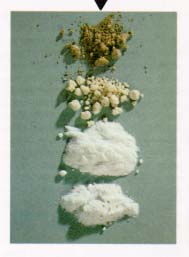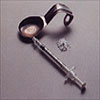Heroin


What are the street names/slang terms for it?
Big H, Black tar, Brown sugar, Dope, Horse, Junk, Mud, Skag,
Smack.
Heroin is a
highly addictive drug, and its use is a serious problem in
America. Recent studies suggest a shift from injecting
heroin to snorting or smoking because of increased purity
and the misconception that these forms of use will not lead
to addiction.
Heroin is
processed from morphine, a naturally occurring substance
extracted from the seedpod of the Asian poppy plant. Heroin
usually appears as a white or brown powder. Street names for
heroin include "smack," "H," "skag,"
and "junk." Other names may refer to types of
heroin produced in a specific geographical area, such as
"Mexican black tar."
What does it
look like?
White to dark
brown powder or tar-like substance.
How is it used?
Heroin can be
used in a variety of ways, depending on user preference and
the purity of the drug. Heroin can be injected into a vein
("mainlining"), injected into a muscle, smoked in
a water pipe or standard pipe, mixed in a marijuana joint or
regular cigarette, inhaled as smoke through a straw, known
as "chasing the dragon," snorted as powder via the
nose.
Health
Hazards
Heroin abuse is
associated with serious health conditions, including fatal
overdose, spontaneous abortion, collapsed veins, and
infectious diseases, including HIV/AIDS and hepatitis.
The short-term
effects of heroin abuse appear soon after a single dose and
disappear in a few hours. After an injection of heroin, the
user reports feeling a surge of euphoria ("rush")
accompanied by a warm flushing of the skin, a dry mouth, and
heavy extremities. Following this initial euphoria, the user
goes "on the nod," an alternately wakeful and
drowsy state. Mental functioning becomes clouded due to the
depression of the central nervous system. Long-term effects
of heroin appear after repeated use for some period of time.
Chronic users may develop collapsed veins, infection of the
heart lining and valves, abscesses, cellulitis, and liver
disease. Pulmonary complications, including various types of
pneumonia, may result from the poor health condition of the
abuser, as well as from heroin's depressing effects on
respiration.
In addition to
the effects of the drug itself, street heroin may have
additives that do not readily dissolve and result in
clogging the blood vessels that lead to the lungs, liver,
kidneys, or brain. This can cause infection or even death of
small patches of cells in vital organs.
Reports from
SAMHSA's 1995 Drug Abuse Warning Network (DAWN), which
collects data on drug-related hospital emergency room
episodes and drug-related deaths from twenty-one
metropolitan areas, rank heroin second as the most
frequently mentioned drug in overall drug-related deaths.
From 1990 through 1995, the number of heroin-related
episodes doubled. Between 1994 and 1995, there was a
nineteen percent increase in heroin-related emergency
department episodes.
Tolerance,
Addiction, and Withdrawal
With regular
heroin use, tolerance develops. This means the abuser must
use more heroin to achieve the same intensity or effect. As
higher doses are used over time, physical dependence and
addiction develop. With physical dependence, the body has
adapted to the presence of the drug and withdrawal symptoms
may occur if use is reduced or stopped.
Withdrawal,
which in regular abusers may occur as early as a few hours
after the last administration, produces drug craving,
restlessness, muscle and bone pain, insomnia, diarrhea and
vomiting, cold flashes with goose bumps ("cold
turkey"), kicking movements ("kicking the
habit"), and other symptoms. Major withdrawal symptoms
peak between 48 and 72 hours after the last dose and subside
after about a week. Sudden withdrawal by heavily dependent
users who are in poor health is occasionally fatal, although
heroin withdrawal is considered much less dangerous than
alcohol or barbiturate withdrawal.
What is its
federal classification?
Heroin is a
Schedule I drug.
Source: NIDA,
DEA
|